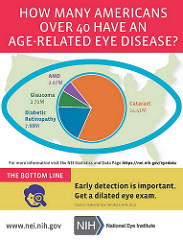Stages of AMD and Related Treatments Including Prevention
PHOTO DEPICTS WHAT SOMEONE WITH AMD SEES. THIS INDIVIDUAL HAS CENTRAL VISION LOSS.
Continuing our month-long focus on Age-Related-Macular-Degeneration (AMD), the disease of the eye that steals our vision, it is time to have a look at the stages of AMD and the treatments used at each stage. According to nei.nih.gov the stages of this disease are as follows:
- Early
- Intermediate and Late
- Advanced neovascular
The early stages of AMD are not detected easily because there is little or no symptoms. There is actually no loss of vision. One way to determine any development of the disease is through dilated eye exams which should be done yearly. When the eyes are dilated the ophthalmologist has a much clearer, deeper view of the macula and retina. Any drusen seen can be a tip off that AMD may be present. Drusen is yellow deposits left beneath the retina which are to a particular degree a normal process. To determine if the drusen are more than a small amount, the dilated exam must be done in order to assess any advancement.

EARLY DILATED EXAMS REPEATED ROUTINELY ARE KEY TO EARLY DETECTION
Certainly any one who wishes to retain their eyesight would like to know how to prevent this disease in the first place. According to our source, studies show that individuals who exercise and eat right have less occurrence of AMD. Eating right can be defined, in part, as eating green leafy vegetables and fish. These individuals also avoid cigarettes. You may have some hard choices to make.
In relation to those with intermediate and late AMD, researchers at the National Eye Institute (NEI) determined that taking high doses of certain vitamins and minerals can slow the progress of AMD in those with intermediate stage in both eyes and/or those with late AMD in one eye. A combination of vitamins C, E and beta carotene along with zinc and copper can reduce the risk of advancing to late AMD by 25%. This formula is called AREDS (age-related eye disease studies). Another trial changed the formula by adding lutein and zeaxanthin or omega-three fatty acids which are all rich in fish oils and green leafy vegetables. At first they found no change in the risk of having AMD until further ingredients were added as well as replacing other ingredients and the risk of advanced AMD was decreased. It is noteworthy that beta carotene is linked to increased risk of lung cancer in smokers (former and current) but lutein and zeaxanthin were safe regardless of smoking status. The ingredients in the AREDS formula can be found in the article linked to this blog. AREDS is not a cure and does not restore vision loss, however it’s use can slow down the progress of AMD and defer the increase of vision loss to a later time.
Advanced neovascular AMD encompasses severe loss of vision. There are, however, some therapies the ophthalmologists use to ward off even further loss. Again, they are not cures, and do not always succeed, but are worth trying. The following are the treatments available:
- Injections
- Photodynamic therapy
- Laser surgery
Injections can slow the progress of neovascular AMD in which abnormal levels of vascular endothelial growth factor (VEGF) are secreted into the eyes. This contains protein that promotes growth of abnormal blood vessels. This growth can be blocked by injection of anti-VEGF drugs. There are quite a few to choose from and they vary in cost as well as how often the injections occur.
Photodynamic therapy injects a drug into the veins and is absorbed by the abnormal vessels. Then the eye care professional uses the laser to activate the drug to slow down the abnormal vessels. The normal vessels are spared. The goal of this therapy is to slow down the loss of vision.
Laser surgery involves the use of a different kind of laser than used in photodynamic therapy. This laser surgery is hot and is aimed at the abnormal blood vessels. This laser surgery can prolong the time one has without severe vision loss.
These treatments may bring questions to your mind that should be asked of your ophthalmologist. Make a list of your questions and take it to your appointment. This article from which this post is taken offers a list of questions you may want to ask.
Remember, our goal is always to provide the best care possible so that our patients may have the best visual outcome available to their individual ocular health.
Credit for the above information is at the following link: https://nei.nih.gov/health/maculardegen/armd_facts



